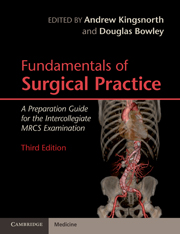Book contents
- Frontmatter
- Contents
- List of contributors
- Preface
- Section 1 Basic Sciences Relevant to Surgical Practice
- Section 2 Basic Surgical Skills
- Section 3 The Assessment and Management of the Surgical Patient
- Section 4 Perioperative Care of the Surgical Patient
- Section 5 Common Surgical Conditions
- 16 Assessment and early treatment of patients with trauma
- 17 Fundamentals of the central nervous system
- 18 Fundamentals of head and neck surgery
- 19 Fundamentals of thoracic surgery
- 20 Oesophago-gastric surgery
- 21 Fundamentals of hepatobiliary and pancreatic surgery
- 22 Fundamentals of endocrine surgery
- 23 Fundamentals of the breast
- 24 Lower gastrointestinal surgery
- 25 Fundamentals of the genitourinary system
- 26 Hernias
- 27 Fundamentals of vascular surgery
- 28 Fundamentals of orthopaedics
- 29 Fundamentals of plastic surgery
- 30 Surgical care of the paediatric patient
- 31 Fundamentals of organ transplantation
- Index
- References
18 - Fundamentals of head and neck surgery
Published online by Cambridge University Press: 03 May 2011
- Frontmatter
- Contents
- List of contributors
- Preface
- Section 1 Basic Sciences Relevant to Surgical Practice
- Section 2 Basic Surgical Skills
- Section 3 The Assessment and Management of the Surgical Patient
- Section 4 Perioperative Care of the Surgical Patient
- Section 5 Common Surgical Conditions
- 16 Assessment and early treatment of patients with trauma
- 17 Fundamentals of the central nervous system
- 18 Fundamentals of head and neck surgery
- 19 Fundamentals of thoracic surgery
- 20 Oesophago-gastric surgery
- 21 Fundamentals of hepatobiliary and pancreatic surgery
- 22 Fundamentals of endocrine surgery
- 23 Fundamentals of the breast
- 24 Lower gastrointestinal surgery
- 25 Fundamentals of the genitourinary system
- 26 Hernias
- 27 Fundamentals of vascular surgery
- 28 Fundamentals of orthopaedics
- 29 Fundamentals of plastic surgery
- 30 Surgical care of the paediatric patient
- 31 Fundamentals of organ transplantation
- Index
- References
Summary
Inflammatory disorders of the ear, nose, sinuses and throat
The ear
Preauricular sinus
Preauricular sinus is a common congenital condition; there is no requirement for treatment unless it becomes infected (Figure 18.1). It may then present with pain, swelling and discharge. If seen at an early stage, infected preauricular sinus may be controlled with antibiotics. If a patient presents with a preauricular abscess, incision and drainage together with antibiotic will then become necessary. The site of incision should be through the sinus opening so as to minimize branching of the sinus tract. This is particularly important with recurrent preauricular abscesses. Abscess formation or recurrent infections are indications that the sinus tract should be excised. It is important that all tracts connected to the sinus should be excised to prevent recurrence. If in doubt, any soft tissue adherent to the tract should be excised as deep as the temporalis fascia.
Auricular haematoma
The pinna, because of its exposed and protruding position, is frequently traumatized. Blunt injury may lead to formation of an auricular haematoma. The haematoma typically forms in the subperichondrial plane. If treatment is delayed, the haematoma may dissect along the subperichondrial plane and result in unsightly deformity. Thus auricular haematoma needs to be evacuated promptly and a pressure dressing applied to conform with the shape of the pinna by means of through and through stitches.
- Type
- Chapter
- Information
- Fundamentals of Surgical PracticeA Preparation Guide for the Intercollegiate MRCS Examination, pp. 306 - 329Publisher: Cambridge University PressPrint publication year: 2011

